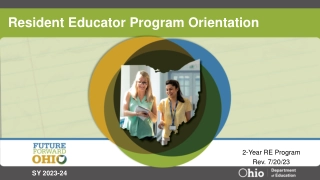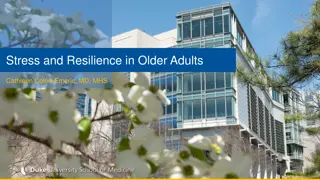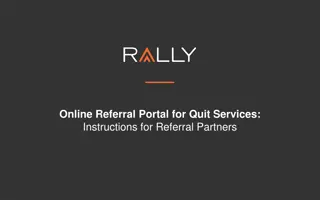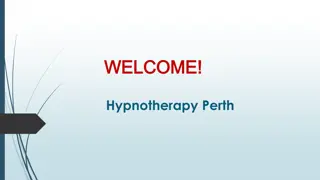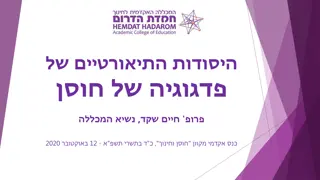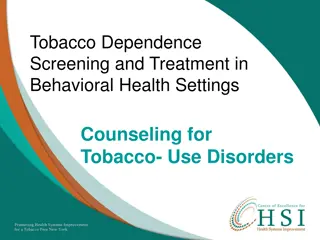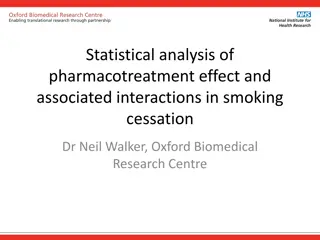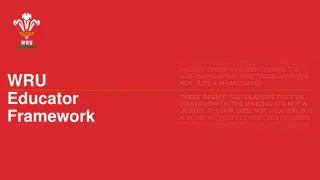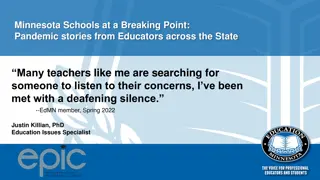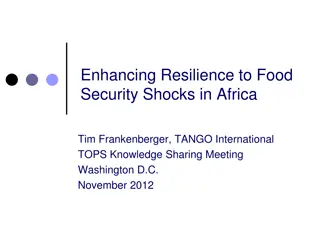Don't Quit!: Strategies for Educator Resilience
This session focuses on increasing personal resilience for educators, addressing the stress and challenges they face in their roles. Explore strategies, research on teacher retention, and interventions to support educator well-being. Learn about common stressors, resilience techniques, and ways to manage challenges effectively.
Download Presentation

Please find below an Image/Link to download the presentation.
The content on the website is provided AS IS for your information and personal use only. It may not be sold, licensed, or shared on other websites without obtaining consent from the author.If you encounter any issues during the download, it is possible that the publisher has removed the file from their server.
You are allowed to download the files provided on this website for personal or commercial use, subject to the condition that they are used lawfully. All files are the property of their respective owners.
The content on the website is provided AS IS for your information and personal use only. It may not be sold, licensed, or shared on other websites without obtaining consent from the author.
E N D
Presentation Transcript
Dont Quit! Increasing Personal Resilience Strategies for Educators Lonna Housman Moline, Ed.D Council for Exceptional Children-President Elect Division of Emotional and Behavioral Health University of St. Thomas 1
Overview & Objectives Understanding how teacher stress and coping skills are interrelated can apprise preventives and interventions to support educators. Outcomes for participants include: Explore common strains of educators Review current research on teacher retention Examine research-based strategies for resilience Discover preventive and interventions for educator support Engage in personal reflection of being an educator Develop positive techniques to manage challenges 2
Teaching is rated as one of the most stressful occupations Current rates of teachers leaving the field are quoted at 10-16% nationally. Improving teacher retention is at the forefront of the profession. Understanding how teacher stress and coping skills are interrelated can inform preventive and interventions to support educators. This session will explore common strains of educators, explore strategies to build resiliency, and provide opportunities for personal reflection. Approaches for increasing personal resilience are based on research and will be modeled. 3
Special education teachers need more mental health initiatives (Edsource) Teachers can be heard saying, the stress of recent years has led me to question my ability to carry on. There will come a point when I must prioritize my health over my career. According to the National Center for Educational Statistics,(2022) 45% of schools reported unfilled positions in special education roles, with 78% citing difficulties in hiring special education staff for the current school year. 4
Stress and Special Educators Stress experienced by special educators is deeply ingrained in the inherent nature of their roles and in the perceptions surrounding them. A key contributing factor is the idealization of special education teachers by schools, often portraying them as extraordinary individuals who are characterized as nurturing and self-sacrificing, willing to prioritize their students well-being over their own. It s commonplace to hear general education teachers express sentiments like, I could never do what you do. This portrayal creates unrealistic expectations for special educators, adding to the systemic sources of stress, which include unequal resource allocation and a shortage of adequately trained support staff. 5
Primary Sources of Stress Daily management of challenging behavior exhibited by students in class without enough staff support. Stress affects students by hindering effective instruction, classroom management and the modeling of social-emotional skills. Stressed teachers are more likely to react unpredictably and employ ineffective behavior management strategies. (Edsource) 6
Primary Sources of Stress continued 'It's the endless stream of new government initiatives, the targets, the constant Ofsted monitoring,' she said. 'But because you know it's the children who benefit, you end up pushing yourself to excel in everything that's thrown at you. Of course that's impossible, so you end up feeling like you're never able to do anything well enough. You don't see that you've worked yourself into such a state of exhaustion that you're too tired to benefit the children anymore. You end up with your self-confidence and self-esteem on the floor.' (Depressed and Stressed, The Guardian) 7
Teach Self Care Strategies Schools must implement programs dedicated to teaching self-care strategies and allocate resources to support these educators mental health and overall well- being. These initiatives should involve professional development programs that prioritize physical wellness, encompassing exercise, dietary choices, and sleep, to sustain energy levels and enhance emotional resilience. 8
Social Emotional Learning Skills It is vital to equip special educators with training in social-emotional learning skills. Training should cover the establishment of clear boundaries between their professional and personal lives, mindfulness practices, participation in yoga, and learning relaxation techniques. Acquiring these skills can significantly reduce stress levels among special educators and provide positive role models for students who are also learning these skills in their classes. 9
Creating Supportive Communities Special education teachers can create informal communities of practice with colleagues based on shared interests, facilitating connections with mentors, and therapists to seek guidance and share their experiences. County based support community-example These communities of practice can strengthen self-reflection practices to recognize and manage stressors effectively. 10
It is essential that schools prioritize special educators well- being Support and implement targeted self-care strategies to sustain the educator's passion and dedication. This approach not only Safeguard the mental and emotional health of educators Enriches the educational experience for students with disabilities 11
5 Strategies for Recovering After Your Worst Day Teaching Johanna Rauhala, Edutopia Ice crystallized on the windshield, then a tire burst on the way to school, making you late. By the time you arrived, the computer (with the video clip and presentation cued up) froze. Minutes later, Jason pulled the fire alarm while you tried to catch up on parent emails. During lunch duty, a student was punched in the nose. Your nose is stuffy while you explain to the principal right before an IEP meeting why your plans haven't been submitted yet. The day trudges along. . . At last, the final bell rings, and in your first quiet moment of the day, thoughts of leaving the teaching profession suddenly seem, well, right. It's that moment when you want to say, "I quit!" 12
True Story 13
It's Not a Secret Most teachers, at some point, feel like giving up. We feel the weight of not having done enough, feel the frustrations of negative media attention, and feel challenged by apathetic or disruptive students. Sometimes, it's overwhelming. That's when our tasks feels insurmountable and we can feel hopeless. We want to quit. We're tempted to call in sick and plan for a sub. That can be too much work or the right call. You can take that empathy and understanding normally reserved for students and focus it on yourself. You can consider some strategies for gently accepting your circumstances, reflecting on what is needed, and preparing to return tomorrow. 14
Another Way Use the empathy and understanding normally reserved for students and focus it on yourself. yourself. Consider some strategies for gently accepting your circumstances, reflecting on what is needed, and preparing for tomorrow. What strategies? What strategies? (Edutopia) 15
1. Find a Friendly Shoulder Call a trusted colleague, preferably one who's been teaching a long time. Vent Cry Laugh hysterically Have a beverage Tell them about your struggles and frustrations All teachers can recount a story of a crazed student or parent. Just ask them. All teachers can recount a story of a crazed student or parent. Just ask them. 16
2. Breathe This sounds simple, and it is. Sit with the discomfort and notice it. Acknowledge frustrations of the day and then let them go. Listen to your self-talk and try to be kind to yourself. Practice slow breathing. If possible, carry this habit into your workday. It will create space for less reactivity and a more grounded emotional stance. 17
3. Plan for Community Consider pausing the scheduled lesson, and instead, take time to engage in team building activities with your students. Connect with YOUR community of support. 18
4. Prioritize Stacks of papers on your desk? Parents waiting for your email? Field trip permission slips to process? Lesson set up for tomorrow? When tasks overwhelms you -- write a list of everything that needs to get done in the next two days. Look at this list and choose the top three tasks. These three are the must-dos, urgent actions that will help you survive until the next day. After completing the must-dos, cross them off your list and go to sleep early. 19
5. Get Perspective Devoting all our waking hours to teaching primes us for burnout. It happens when the demands and expectations of our work drown out our joy. Your other roles are important, too: friend, spouse, sibling, hiker, reader, dancer, joke- teller, or baker. These other aspects of your personality need need attention. Go to the forest or to a ball game. Get a massage. Read a book. Hang with your family and friends. We can be good, caring, effective teachers, without sacrificing our personal lives. 20
How to Relax Perceive Reframe Laugh Breathe Play 21
Promoting Wellness for Educators: Promoting Wellness for Educators: Strategies and Results Strategies and Results 22
Powerful Professional Development 100% satisfaction with training objectives learn strategies to help reduce stress learn strategies to be more positive model strategies to use with students Reduces educators immediate distress 85% of the time Produces positive impact for stress reduction and increase of overall workplace wellbeing! 23
Professional Development sessions for increasing well-being offer a convenient and beneficial opportunity for a support network that cultivates resilience. Attending to the well-being of special education staff is a win-win situation. When staff are flourishing, both student learning and teacher retention can increase. In a survey of teachers, 85% reported they felt there was a need to develop policies 85% reported they felt there was a need to develop policies that would enhance the wellbeing of teachers. that would enhance the wellbeing of teachers. However, with the demands of the job, many teachers may feel they do not have the time to create and maintain such support systems (Ferguson, Frost, & Hall, 2012). 24
Developing a Program 2017- All district Back to School assembly Positive psychology strategies, well-being, social emotional learning Presented at numerous conferences and districts I suggested having workshops for our special education staff, got approval, designed sessions 25
Approved! Professional Development during the school year New Teacher Training Summer Academy o One of the top 3 attended sessions o Includes all staff (general education, support staff) 26
All strategies are backed by research and are presented to participants along with actual activities to practice the strategies Art Mindfulness Reflection Celebrations Reframing Perspective taking Play 27
Workshops & Trainings Rewards and Reinforcement Frame It Relaxation Examining Our Explanations Be Ridiculous Celebrations are Critical Increasing Passion at Work Anchor Your Awesomeness We Need A Parachute Stop Driving Yourself Crazy Working Through Conflict Fun and Laughter Relationships are Required Banishing Burnout The Relevance of Reflection Sink Self Sabotage 28
Planning the session Sessions were each 2 hours Relaxed, fun, snacks, drawing for prizes Sessions provided resources for staff s personal use, as well as resources to take back to the students. Consistent day and time Participants register through our SPED website. Paraprofessionals are paid their regular salary. Teachers are paid our PD rate. 29
Comments from Participant Surveys We were provided great articles Fun, relaxing class and atmosphere I found the cognitive reframing information to be very helpful I can see using this with my students I like all the different resources you provided The structure of the session is good. LOVE the projects that tie in the lesson! I liked the mix of research and opportunity to try things The opportunity to actually practice what was discussed Ideas that were given for us were also made appropriate for classroom 30
Data Collection Investigate educators levels of stress and explore what effect professional development, focused on personal wellbeing, had on educators. Understand how teacher stress and coping strategies are interrelated in order to provide preventive and intervention strategies to support educators. Subjective Units of Distress Scale* SUDS Perceived Stress Scale* PSS Workplace PERMA-Profiler PERMAH Informal Survey* Wellness Survey *Used google form 31
Method A series of 5 professional development sessions was offered to all Special Education Staff. Sessions focused on personal well-being strategies. Each 2 hour session had a wellness topic, research-based strategies, and provided time for participants to practice a strategy. While strategies were focused on staff use, all strategies could also be used with students. Sessions also allowed time for staff to connect in a positive, relaxed environment. 32
Participants teachers paraprofessionals speech/language clinicians work experience coordinators They self-selected which session they attended. Group size ranged from 13-15. Eight participants attended four or five sessions. Others attended three or less. 33
Results Subjective Units of Distress Scale (SUDS) Subjective Units of Distress Scale (SUDS) The SUDS is a tool for measuring the subjective intensity of distress currently experienced by an individual using a scale of 0 to 10. Self assessment, individual identifies their current distress level on the scale. 34
Results continued The SUDS was given to participants at the start and end of each session (pre/post) Collected electronically Average decrease of reported distress was 2.6 4 instances where the level of stress showed no change 2 reports of an increase in stress Lowest average level of distress 2.2 reported after the final session 35
Results continued 2 Average reported distress level at start and end of each session PRE November 4.7 January 5.5 February 5.0 March 6.5 April 4.8 POST 2.5 3.1 3.1 3.5 2.2 36
Further examination of rating scores 23 out of 125 responses fell in the elevated range, equal to or above 7 41 out of 125 responses fell in the middle range, defined as rating 4 to 6 62 out of 125 responses indicating low distress, defined as rating 3 or less Higher ratings were indicated at the start of the session 91% of the time **Eighty **Eighty- -four percent of the low distress ratings were recorded immediately following the four percent of the low distress ratings were recorded immediately following the wellness session. wellness session. 37
Perceived Stress Scale (PSS) PSS is a classic stress assessment instrument. Developed in 1983 and continues to be a popular choice for understanding how different situations affect one s feelings and perceived stress level. Questions assess general level of stress, not specific to the workplace. 38
Perceived Stress Scale (PSS) continued Individuals are asked to indicate how often they felt or thought a certain way over the past month. Some examples of questions include: In the past month, how often have you felt unable to control the important things in your life? In the last month, how often have you felt confident about your ability to handle personal problems? In the last month, how often were you able to control irritations in your life? 39
Perceived Stress Scale (PSS) continued 2 Individual total scores on the PSS can range from 0 to 40 with higher scores indicating higher perceived stress. Scores ranging from 0-13 are considered low stress. Scores ranging from 14-26 are considered moderate stress Scores ranging from 27-40 are considered high stress Scale was used to collect staff stress levels over the course of the school year Given to participants 5 times between November and April Distributed via email a few weeks after each session Participants were encouraged to fill out the scale each time, regardless of attending the previous session 40
Results from the PSS Results from the PSS showed the earlier part of the school year was the most stressful (November) and April was the least stressful. The average reported stress level for each month fell within the moderate (14-26) range. Average level of stress for each month November 22.66 January 20.68 February 21.05 March 21.38 April 20.00 *Average 21.15 41
Compared to the Norm Norms as reported by Cohen (1994) Mean score of 12.1 for males Mean score of 13.7 for females When comparing scores from this study to the female norm, educators average stress level was 7.45 points higher than the norm. level was 7.45 points higher than the norm. educators average stress 42
The Workplace PERMA-Profiler The Workplace PERMA-Profiler collected data specific to the workplace Workplace PERMA is a variant of the PERMA-Profiler, which is a general measure of flourishing for adults. It measures the 5 domains of flourishing (as defined by Martin Seligman), including positive emotions positive emotions, engagement, relationships, meaning, and accomplishment. accomplishment. engagement, relationships, meaning, The Workplace Profiler changes the context of the questions to the work environment Individuals are provided with a report on their PERMA and strategies to increase their well-being 43
Results from the Workplace PERMA Profiler Increase in Increase in Overall Workplace Wellbeing Overall Workplace Wellbeing Average score in November was 6.71 and at the Average score at end of the sessions, April, was 7.91 1.2 increase 1.2 increase 44
Informal survey Collected using a google form 17 respondents Responses were all positive 94% responded that the sessions were a good use of their time -One person responded mostly 45
Informal survey continued When asked if they learned something to help them reduce stress learned something to help them reduce stress, 47.1% strongly agreed and 52.9% agreed. When asked if they learned something to help them be more positive learned something to help them be more positive, 52.9% responded strongly agree and 47.1% agreed . Sessions also modeled strategies they could use with their students modeled strategies they could use with their students. When asked if this objective was achieved 41.2% strongly agreed and 58.8% agreed. All respondents indicated that they would like to attend additional sessions. All respondents indicated that they would like to attend additional sessions. 46
Informal survey comments healthy way to connect with other staff, positive tools to use, activities connecting with colleagues, getting resources, time to rejuvenate sharing our experiences and hearing others' stories relaxed, small group, learning information that I can use at work and in everyday life creative projects that let us collaborate with colleagues from other buildings helped me to see certain things that we can adopt in our daily life, for Ex: Gratitude, Self Compassion which can change our perspective each session included a project that I could take back and do with my class format of presenting relevant research first and then doing a mindful activity with some room for creativity was both informative and stress-relieving. I loved it! 47
Individual Session Data Results assessing participants stress levels reduction of reduction of 2.6 data points 2.6 data points on a 1-10 scale. Higher distress ratings were indicated at the start of the session 91% of the time. Low distress ratings were recorded immediately following the wellness session 85% of the time. Wellness sessions had a positive impact in immediately reducing distress. Wellness sessions had a positive impact in immediately reducing distress. When considering a change in distress levels distress levels over the course of the school year and five sessions, the average score on the PSS decreased from 22.66 to 20.00. Results from the Workplace PERMA-Profiler showed an Workplace Wellbeing Workplace Wellbeing rising rising from 6.71 to 7.91. from 6.71 to 7.91. stress levelsat the individual sessions showed a decreased from 22.66 to 20.00. an increase in increase in Overall Overall 48
Relevance & Importance When the research shows teachers with significant stress levels and low coping skills are associated with the poorest student outcomes, it becomes glaringly important to provide outlets and interventions to assist educators in reducing negative stress. This study validated the elevated stress levels of educators and showed that wellness This study validated the elevated stress levels of educators and showed that wellness strategies can reduce distress and increase overall workplace wellbeing. strategies can reduce distress and increase overall workplace wellbeing. 49
Resilience and Coping Skills (Harrison, Hoon, & Floet, 2021) Resilience includes internal factors and external supports to overcome stressful events. When external supports are not present, stress can become toxic. Problem-focused coping concentrates on resolving the problem. There are 3 subscales: positive reinterpretation and growth; active coping; and planning. Problem- focused coping can lead to the problem being successfully resolved, promoting competence and self-efficacy. Avoidant emotion-focused coping, such as denial, venting, emotion and behavioral disengagement, uses strategies to lessen the negative affective response to the stressor. This might alleviate the immediate negative effects for the individual, however, is only temporary and the problem is unresolved. 50


